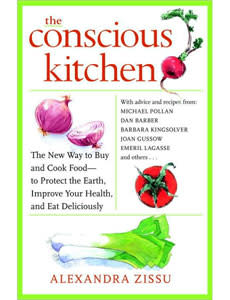How Well Do You Really Eat? Take the Conscious Kitchen Challenge!
As a longtime The Daily Green blogger, on the occasion of the publication of my second book, The Conscious Kitchen, I'm using my "Ask An Organic Mom" space for the next 8 weeks give or take to invite you to join me on the Conscious Kitchen Challenge.
What does it mean to have a Conscious Kitchen? It's a little different for every person, but at its heart, it means knowing where your food comes from, what it is, and how good it is (or isn't) for you and for the environment. It also encompasses the energy it takes to cook, what you're cooking on and storing food in, and even how you clean up and handle waste.
We all know we need to be eating better foods local, organic, local and organic, humanely raised meat, wild and well-caught fish, packaged foods containing five pronounceable ingredients or less but they're not always so easy to find. Or it's not always so easy to motivate to find them. Think of this like you think of New Year's resolutions. Choose your own personal goal make it attainable for better success and then together we'll methodically get you there. Keep in mind that any conscious steps are better than no conscious steps 10 percent is better than no percent.
Week 1 Challenge: The Self Exam

The first step in creating a more Conscious Kitchen is to perform a self-exam of sorts. Walk into your kitchen and see what's in there. If this seems too daunting, there's nothing wrong with cracking a bottle of wine (made from sustainably grown grapes!) if it helps get you in the mood. I've devised a simple scoring system to let you see how you're doing.
OVEN & STOVE:
Are you cooking? Maintaining a Conscious Kitchen does involve cooking often at home. No need to do anything fancy. We'll talk about the materials you might be cooking on in a few weeks.
Challenge: Honestly assess how many times you cook per week, and then challenge yourself to increase the number of meals you make at home. Ask yourself what you need to make this goal a reality. Is it as simple as a weekly list of meals, coupled with a shopping list? Is it the right cookbook to re-ignite your excitement about cooking? Is it a plan with your partner to share the responsibilities?
Scoring: Add 1 point for every meal cooked at home; subtract 1 point for takeout.
CABINETS:
Throw them open wide and see what's there. Read ingredient lists how long are they? Can you understand all of the words? What countries are they from? What states? Do any of the items have unverified claims like "natural" on them? Is anything in there organic? What is the packaging like canned vs. plastic vs. cardboard boxes? Is it made from recycled materials? Can you recycle it? Can you compost it? What do you see in here that you think is good Conscious food and what's in here that you don't like?
Challenge: If you come across an ingredient you don't know, say it out loud. Try to define what it is (Google helps!), where it comes from, how it's made and why it's in your food at all then decide if you still want to consume it. Visualize how that packaging was produced, and visualize where it will go once you're done with it. Make a plan to reduce the overall amount of packaged foods you're eating, especially processed packaged foods. Decide what you'd like to change in your cabinets and set attainable goals about replacing processed foods with whole foods.
Scoring: Do this based on one packaged item. Add 1 point for every ingredient you know, 2 points for local and/or organic items, 3 points if the packaged item has 5 ingredients or less and you know, can pronounce and visualize all of them. Subtract 1 point for every ingredient you can't pronounce, and 2 points if you can't visualize it. Subtract 2 points for anything with several layers of packaging (plastic and cardboard).
FRIDGE:

What's in your fridge? Notice the ratio of fresh whole foods to packaged items. Are your veggies wilting or are they something you shop for often? How many ingredients are listed on that plastic bag of sliced bread? What's in here that you think is Conscious, and what would you like to see go?
Challenge: Repeat the process for your fridge. Try to visualize how each ingredient was produced. Do you picture a farm? Do you know where that farm is located and how it produced that ingredient? Or does is it an ingredient that you might expect to find in the cleaners under the kitchen cabinet, as opposed to in your fridge? Make a plan based on the experience, and set goals on how best to get the Conscious foods you'd prefer to be in your fridge. The challenges in the coming weeks will help you define ways to find the right food for you.
Scoring: Add 1 point for every whole food item, 2 points if it's not only whole but also organic and local. Give yourself 2 more points if the whole food items don't come in any packaging at all. Subtract 1 point for non-organic or non-local fruits and veggies, another 1 point for packaged multi-ingredient items, and 2 points for every bottle of water, soda, and/or non-organic animal products like milk, cheese, and yogurt.
FREEZER
Do you have mainly frozen cuts of meat and one-ingredient bags of things like peas? Or is this where you keep multi-ingredient processed meals you microwave nightly? Or is this a vast wasteland with nothing more than vodka?
Challenge: Repeat the process in the freezer, where ready-to-eat processed foods often lurk. Consider all you've already purchased and brought into your home and size it up what else would you prefer lived in your freezer? What are other ways you can store tomorrow's food today? What staple ingredients do you want on hand, and which are missing? Make a list (mental or otherwise) of what you want, and how you plan to obtain it.
Scoring: Add 3 points for local, sustainably raised and humanely slaughtered meat devoid of hormones and antibiotics, and 2 points for soups and other meals you've pre-made and stored in glass jars. Give yourself 1 point if your ice cream is organic, and has a manageable ingredient list. Subtract 3 points for conventionally raised meat, 2 points for processed packaged microwaveable meals with long, confusing ingredient lists.

TRASH
Take a look at your trash. What's in there? How often are you filling a bag? Are you recycling everything you can? What are you throwing out that isn't recyclable? Visualize where those items began, and where they will end up after you put the bag on the curb.
Challenge: Challenge yourself to consider each item you throw out before depositing it in the trash. With each thing you throw out, consider alternatives and make a mental note about how you can cut down on waste before it gets to the trash. Are you willing to compost?
Scoring: Add 2 points if you recycle all you can and fill a bag infrequently. Add 3 points if you're composting. Subtract 4 points if you're not recycling items your municipality takes, and another 2 if you're filling and tossing an entire garbage bag daily.
Your Conscious Kitchen Diagnosis
Use this get-to-know-your-kitchen challenge as a learning experience. Mull over all you've seen in your kitchen. Make your wish lists. In the coming weeks, I'll tell you where to find every Conscious food your heart desires, no matter where in the country you live or what sort of access to farmers' markets you have.
Meanwhile, feel free to take to comments to share details on hilarious things you found in the back of your cabinets (I'll tell you mind if you tell me yours!), things you're loathe to give up, and any and all of your hopes and dreams regarding your Conscious Kitchen.
Overall Scoring: How did you do? If you came out positive, good for you. If you're in the negative, you have your work cut out for you. Do this scoring exercise again at the end of our 8 weeks to see how far you've come.
The Conscious Kitchen: The New Way to Buy and Cook Food - to Protect the Earth, Improve Your Health, and Eat Deliciously is an invaluable resource filled with real world, practical solutions for anyone who has read The Omnivore's Dilemma or seen Food, Inc. and longs to effect easy green changes when it comes to the food they buy, cook, and eat.
posted by Alexandra
Reprinted with Permission of Hearst Communications, Inc.

